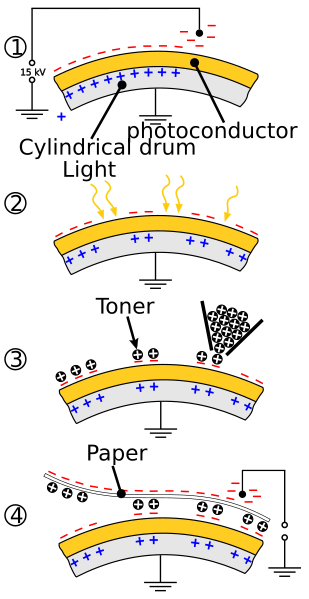Archivo: Xerographic photocopy process en

Descripción: Schematic drawing of the xeroxgraphic photocopying process. Vectorization of the image. Original image made by 'Wschneider' on the German Wikipedia. Charging: The surface of a cylindrical drum is given an electrostatic charge by either a high voltage wire called a corona wire or a charge roller. The drum is coated with a photoconductive material. A is a semiconductor that becomes conductive when exposed to light. Exposure: A bright lamp illuminates the original document, and the white areas of the original document reflect the light onto the surface of the photoconductive drum. The areas of the drum that are exposed to light (those areas that correspond to white areas of the original document) become conductive and therefore discharge to ground. The area of the drum not exposed to light (those areas that correspond to black portions of the original document) remain negatively charged. The result is a latent electrical image on the surface of the drum. Developing: The toner is positively charged. When it is applied to the drum to develop the image, it is attracted and sticks to the areas that are negatively charged (black areas), just as paper sticks to a toy balloon with a static charge. Transfer: The resulting toner image on the surface of the drum is transferred from the drum onto a piece of paper with a higher negative charge than the drum.
Título: Xerographic photocopy process en
Créditos: Trabajo propio
Autor(a): Yzmo
Términos de Uso: Creative Commons Attribution-Share Alike 3.0
Licencia: CC BY-SA 3.0
Enlace de Licencia: https://creativecommons.org/licenses/by-sa/3.0
¿Se exige la atribución?: Sí
Usos del archivo
La siguiente página enlaza a este archivo:

